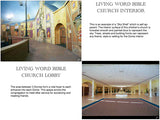Since the beginning of time the round building has been recognized as a place of worship. the oldest continuously used building in the world is the Pantheon in Rome. Built in 126 A.D. and originally used for religious purposes, it is the monolithic concrete dome’ oldest cousin. Many native cultures on different continents today, still reference the circle and the round house as a sacred location.
In the Christian Era, following the death of Christ, many of the greatest buildings were build in the shape of domes, or included a dome as part of the worship structure. The Haga Sophia in Turkey, S. Peters in London, the Vatican in Rome, the Crusaders Chapel in Jerusalem, and many other famous ancient structures were constructed around the Roman engineering principles of design.
Today, the modern Christian Church has evolved into lineal design, spurred mostly by the European – Scandinavian practice of cutting trees and building wooden trusses. The width of a church building was always limited by the spanning abilities or wood timber, necessitating the long narrow assembly halls for larger congregations. This practice carried over to the Americas in the 15th century and continues to shape churches today. The limited ability to see and hear within these structures became accepted practice after several centuries.
Things have changed! Enter the monolithic concrete dome with its almost unlimited span capabilities and large interior volume. It has become the most natural shape for a worship space and at the same time, is becoming more closely the natural shape of a congregation sitting down on the ground around their central speaker.
Related Links Related Products









